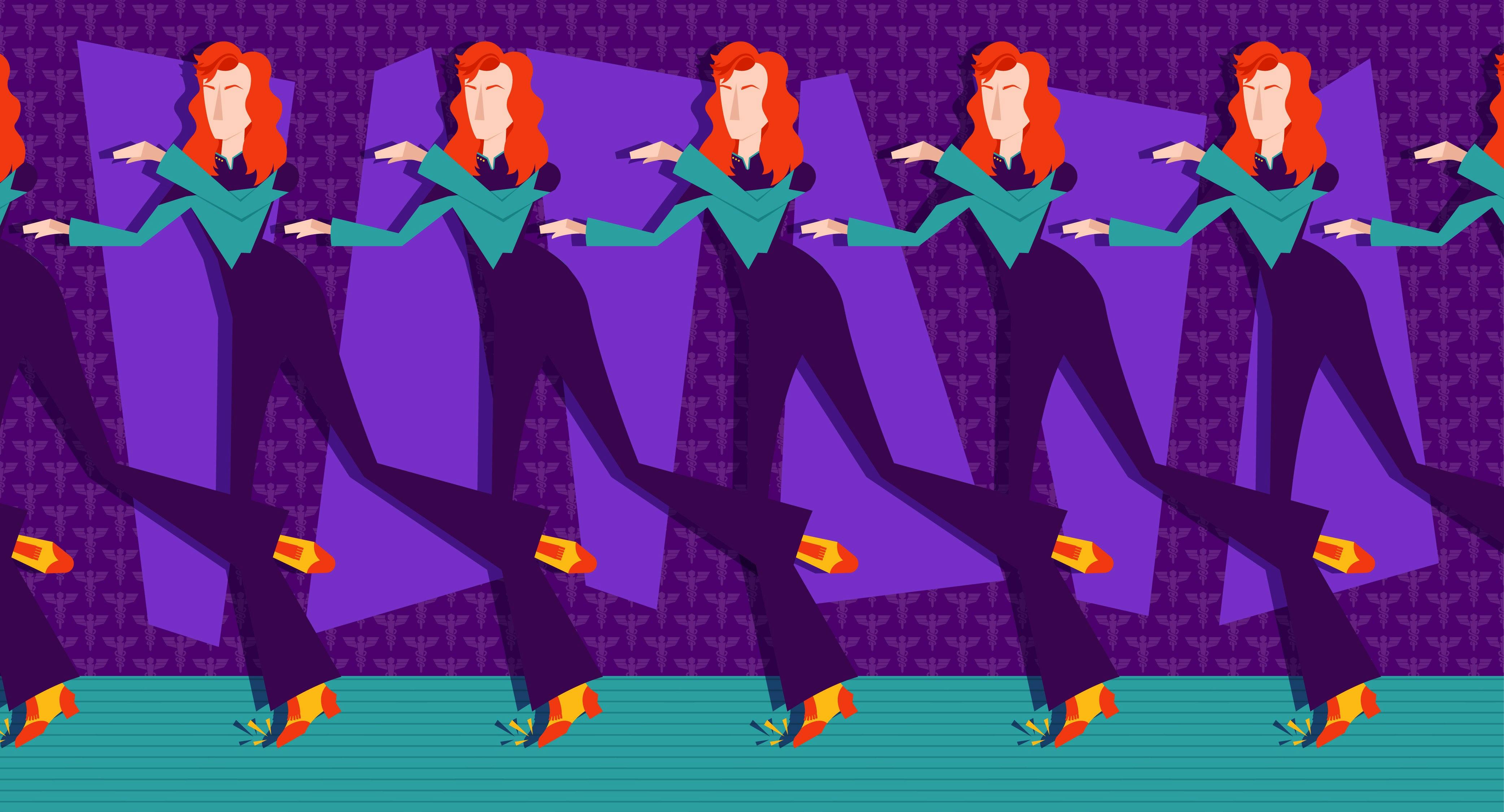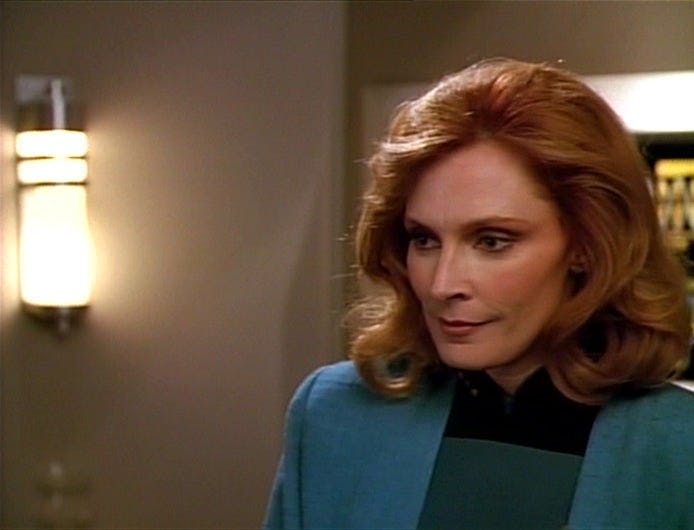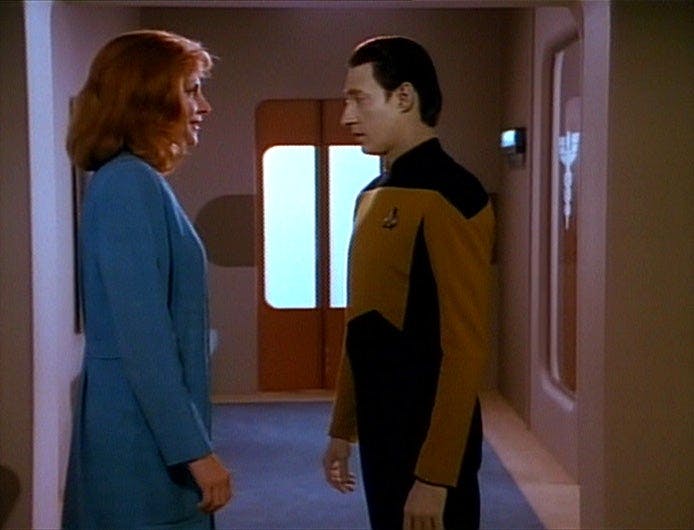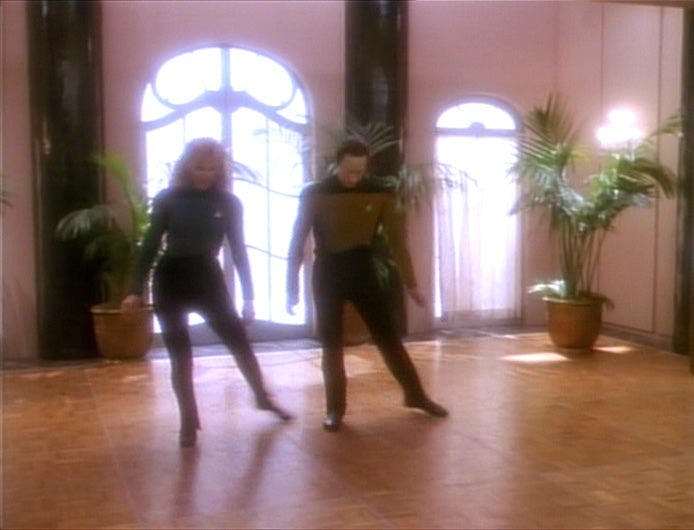Published Mar 2, 2022
The Power of the Dancing Doctor
Especially now, it's important to remember that Dance is among the most human and healing of activities.

StarTrek.com
This article was originally published in 2020.
Long before her posting as Chief Medical Officer aboard the Enterprise-D, Beverly Crusher was a dancer. In the episode “Data’s Day,” Data notes that Dr. Crusher received awards in tap and jazz dance in St. Louis. Dr. Crusher cuts him off, asking him not to let her nickname “The Dancing Doctor” be revived. But Beverly needn’t have been embarrassed by her nickname, as it is actually very beautiful. As soon as our ancient ancestors walked out of their caves, they danced. Dance is among the most human of activities. It’s no wonder that Data, in his quest to become more human, sought to learn how to dance from Dr. Crusher. After all, a doctor who dances adds a wonderful element to their treatment arsenal.
In a conversation about dance with Ted.com, Sir Ken Robinson, Professor Emeritus at the UK’s University of Warwick, stated: “It is the physical expression through movement and rhythm of relationships, feelings and ideas. Nobody invented dance. It is deep in the heart of every culture throughout history; dance is part of the pulse of humanity. It embraces multiple genres, styles and traditions and is constantly evolving. Its roles range from recreational to sacred and cover every form of social purpose.”
Among these social purposes are the medicinal and therapeutic. Though obviously not always an appropriate replacement for surgery or other traditional medical treatments, dance can play a significant role in a comprehensive recovery for patients suffering from physical, emotional, mental, or spiritual traumas.

StarTrek.com
A key tool in these recoveries is Dance Movement Therapy (DMT). The American Dance Therapy Association defines DMT as “psychotherapeutic use of movement to promote emotional, social, cognitive, and physical integration of the individual, for the purpose of improving health and well-being.”
Pat Debenham, a retired Professor of Dance at two Utah-based universities, cites dance theorist Rudolph von Laban to explain: “Laban referred to our beings as ‘body/mind’ giving primacy to our physical experiences. They often create and condition our emotional, intellectual and spiritual responses to our environment and how we interact in relationships. Learning to ‘tune-in’ to physical sensation is at the heart of DMT; it helps us understand triggers. By doing so we begin to notice, understand and modulate our reactions. Dance provides one with a holistic, integrated sense of one’s self. It also, when used both improvisationally and in repeated patterns, rewires circuits in the brain.”
This is something I’ve seen first-hand. My mother, Cathy Black, opened her first dance school in her parents’ basement in 1961, when she was 14 years old. She, like Dr. Crusher to Data, taught tap dance and later formed the Alberta Tap Dance Association. She went on to become a Professor of Dance, teaching at the university level for 40 years. I watched her choreograph countless pieces (and even performed in a couple myself, though without what I would call any level of talent or ability), present numerous lectures, and even help a small neighbor girl learn to move again after a very serious car accident nearly killed her. My mom won several awards and served on the boards of international dance academic organizations. This was all until 2012, when she was diagnosed with Alzheimer’s Disease and vascular dementia. She was forced to retire prematurely as a result of the mental deterioration that had invaded. It was incredibly difficult to watch this brilliant woman lose control of her faculties. Except for dance. Dance had been her life. Her heart. Her soul. Her very being, remaining with her literally until the days before her death in January 2019. Her care center provided our family with this video showing how deeply ingrained in her dance was.
It was literally the only thing she retained from her pre-dementia life. And it brought her safety and joy in a world that grew ever more confusing and frightening.
Dr. Crusher’s real-life alter-ego Gates McFadden is an accomplished dancer and choreographer in her own right. She is perhaps best known for choreographing the Jim Henson film Labyrinth as well as the dance sequences for “Data’s Day.” When I shared the video of my mom with her, she responded with great compassion and kindness on Twitter.
oh Jake! both beautiful and heartbreaking. thank goodness for dance in her life. She seems utterly lovely! https://t.co/G45skdtsgY
— Gates McFadden (@gates_mcfadden) August 6, 2018
For my mom, dance was beyond something she liked to do. It was more than therapeutic. It was lifesaving and life extending.
Ariel Hortin, who in 2022 will complete her master’s degree and certification as a Dance Movement Therapist at Lesley University in Cambridge, Massachusetts, also experienced first-hand the therapeutic power of dance as a teacher in the both the public school and university systems.
“I had a class of students that I really wanted to do something different with, and after some discussion together, we decided that we needed to dance about addiction. This was a random beginning dance class, not a recovery therapy group where people came to talk about addiction, yet all twenty-three students had a significant connection to addiction in their lives.

StarTrek.com
“Most had a parent, spouse, or close family member dealing with addiction. Others were dealing with personal addictions, including opioid addiction and self-harm. By the end of the semester, two had reunited themselves with estranged loved ones. Two had joined local addiction support groups. One checked herself into a rehab facility. The students shared that they learned that the opposite of addiction is connection and that healing comes through being able to share their stories.
“Since then, I have been able to dance many projects with my students, working through subjects such as sexual assault, perfectionism, social media pressure, disordered eating and diet culture, identity, and grief. I have seen that if we dance the stories we cannot speak, we not only create powerful art, we create powerful people.”
Much like my mom and Ariel’s students, my wife Michelle is a beneficiary of the therapeutic influence of dance. Shortly after my cancer fight, Michelle was diagnosed with bipolar disorder. For her, dance is as important an element in managing her mental illness as medication and traditional therapy. Michelle uses dance as a form of creative expression—sharing the innermost thoughts and feelings she faces as one with bipolar—and also as a form of physical healing. Dance classes have been formally prescribed by her medical and psychological doctors. The more active she is in movement, the greater her ability to manage the challenges that accompany bipolar disorder. It brings endorphins, to be sure, but it also centers her. Helps her come back to herself. Helps her manage. Helps her overcome.
“Dance isn’t just ballet or tap. It is all forms of movement. I see dance in yoga, in sports, even in minute movements of a newborn baby,” Michelle says.

StarTrek.com
Ariel agrees, “Any type of movement, from biking to boogying, will not only provide better physical well-being but also a great awareness for the mind-body connection. In this case, we encourage all to get out and move. Take a dance class. Find a way to move that speaks to you and it will be a part of your physical and mental health.”
The first dances were recorded as cave paintings. Dance was used in ancient civilizations for everything from fertility to farming, meditation to medicine. It is gratifying to believe that in the 24th century, dance will still have a place in society. Our modern culture needs more Beverly Crushers. More doctors who dance and more dancers who heal.
A Timeline Through the Star Trek Universe
Jake Black (he/him) is a writer whose credits include Star Trek: Starfleet Logbook, Star Trek Magazine, and works for DC Comics, Marvel, WWE, Teenage Mutant Ninja Turtles, Supergirl, and many more. A ten-year cancer survivor, he lives in a quiet Connecticut town with his wife, son, and twin daughters. Found online @jakeboyslim.

